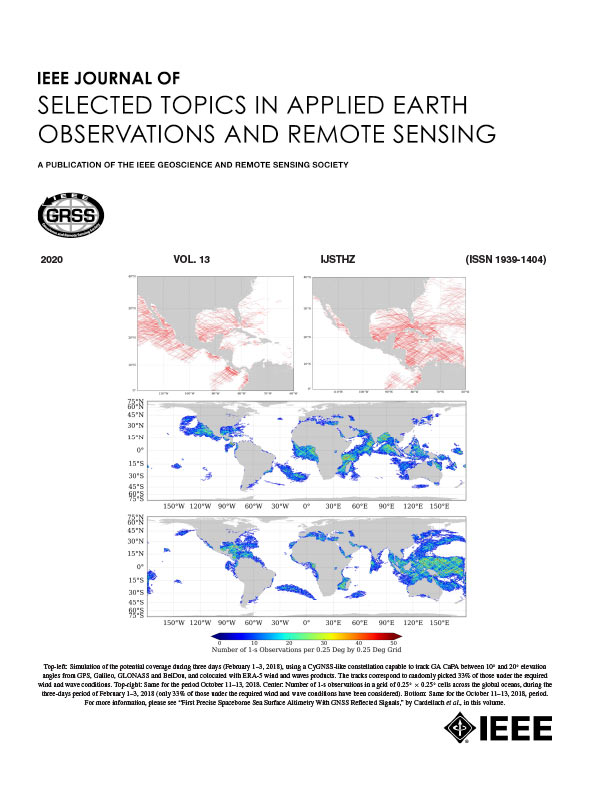Controlled-SAM and Context Promoting Network for Fine-Grained Semantic Segmentation
IF 4.7
2区 地球科学
Q1 ENGINEERING, ELECTRICAL & ELECTRONIC
IEEE Journal of Selected Topics in Applied Earth Observations and Remote Sensing
Pub Date : 2025-06-20
DOI:10.1109/JSTARS.2025.3581620
引用次数: 0
Abstract
Fine-grained semantic segmentation of remote sensing imagery is critical for applications such as land use analysis and agricultural monitoring. However, it remains challenging due to the subtle inter-class differences between visually similar objects, which often result in misclassifications. This challenge becomes particularly evident in distinguishing classes such as rivers, ponds, and fishponds, which share similar spectral and spatial characteristics. To address these challenges, we propose CSCPNet, a novel framework optimized for fine-grained feature extraction and segmentation accuracy. CSCPNet features the controlled-segment anything model (SAM) encoder and the context promoting decoder. The controlled SAM encoder, by using shallow and deep feature fusion modules, integrates multiscale features from both a pretrained SAM encoder and a lightweight encoder, excelling in capturing detailed fine-grained features. The context promoting decoder with context attention is designed to iteratively refine feature maps through multistep decoding, effectively incorporating contextual information. Extensive experiments on FBP and ShengTeng datasets with fine-grained classes demonstrate that CSCPNet achieves state-of-the-art performance in fine-grained semantic segmentation. On the FBP dataset with 24 fine-grained classes, CSCPNet improves overall accuracy (OA), mean intersection over union (mIoU), and mF1 by 4.4%, 6.7%, and 9.3%, respectively. Similarly, on the ShengTeng dataset with 47 fine-grained classes, it achieves gains of 5.5% in OA, 7.3% in mIoU, and 7.9% in mF1. Meanwhile, CSCPNet maintains competitive accuracy in normal segmentation datasets such as Potsdam dataset and CZWZ dataset. These results demonstrate that CSCPNet excels at capturing fine-grained details and effectively distinguishing visually similar classes, making it a robust and efficient solution for fine-grained semantic segmentation of remote sensing images.面向细粒度语义分割的受控sam和上下文提升网络
遥感图像的细粒度语义分割对于土地利用分析和农业监测等应用至关重要。然而,由于视觉上相似的对象之间存在微妙的类间差异,这通常会导致错误分类,因此仍然具有挑战性。这一挑战在区分河流、池塘和鱼塘等具有相似光谱和空间特征的类别时尤为明显。为了解决这些挑战,我们提出了一种新的框架CSCPNet,该框架针对细粒度特征提取和分割精度进行了优化。CSCPNet的特点是控制段任意模型(SAM)编码器和上下文提升解码器。可控的SAM编码器通过使用浅特征和深特征融合模块,集成了预训练SAM编码器和轻量级编码器的多尺度特征,擅长捕获详细的细粒度特征。基于上下文关注的上下文促进解码器旨在通过多步解码迭代优化特征映射,有效地融合上下文信息。在带有细粒度类的FBP和ShengTeng数据集上进行的大量实验表明,CSCPNet在细粒度语义分割方面达到了最先进的性能。在包含24个细粒度类的FBP数据集上,CSCPNet将总体精度(OA)、平均交联(mIoU)和mF1分别提高了4.4%、6.7%和9.3%。同样,在具有47个细粒度类的ShengTeng数据集上,它在OA上实现了5.5%的增益,在mIoU上实现了7.3%的增益,在mF1上实现了7.9%的增益。同时,CSCPNet在波茨坦数据集和CZWZ数据集等常规分割数据集上保持了相当的精度。这些结果表明,CSCPNet在捕获细粒度细节和有效区分视觉相似类方面表现出色,是一种鲁棒且高效的遥感图像细粒度语义分割解决方案。
本文章由计算机程序翻译,如有差异,请以英文原文为准。
求助全文
约1分钟内获得全文
求助全文
来源期刊
CiteScore
9.30
自引率
10.90%
发文量
563
审稿时长
4.7 months
期刊介绍:
The IEEE Journal of Selected Topics in Applied Earth Observations and Remote Sensing addresses the growing field of applications in Earth observations and remote sensing, and also provides a venue for the rapidly expanding special issues that are being sponsored by the IEEE Geosciences and Remote Sensing Society. The journal draws upon the experience of the highly successful “IEEE Transactions on Geoscience and Remote Sensing” and provide a complementary medium for the wide range of topics in applied earth observations. The ‘Applications’ areas encompasses the societal benefit areas of the Global Earth Observations Systems of Systems (GEOSS) program. Through deliberations over two years, ministers from 50 countries agreed to identify nine areas where Earth observation could positively impact the quality of life and health of their respective countries. Some of these are areas not traditionally addressed in the IEEE context. These include biodiversity, health and climate. Yet it is the skill sets of IEEE members, in areas such as observations, communications, computers, signal processing, standards and ocean engineering, that form the technical underpinnings of GEOSS. Thus, the Journal attracts a broad range of interests that serves both present members in new ways and expands the IEEE visibility into new areas.

 求助内容:
求助内容: 应助结果提醒方式:
应助结果提醒方式:


